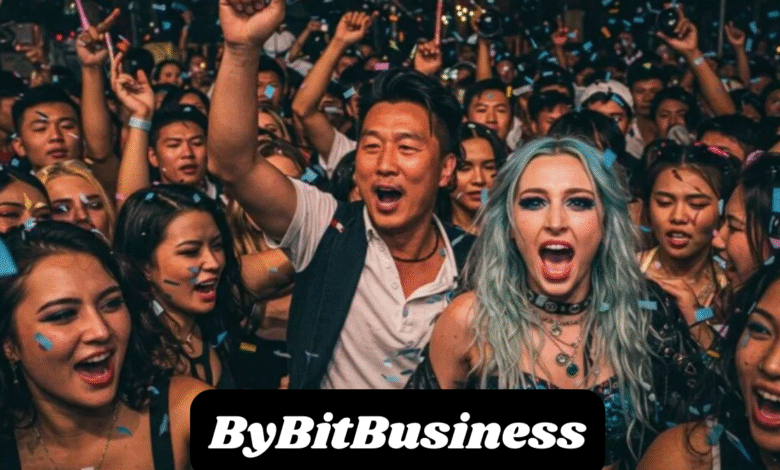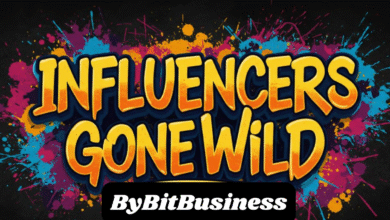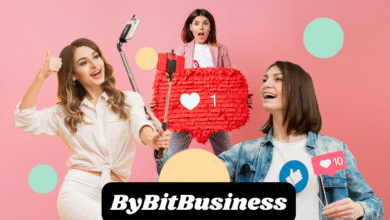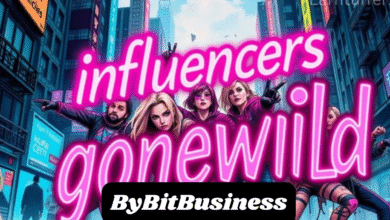The Impact and Influence of “I fluencersgonewild”: A Cultural and Digital Revolution

In recent years, the term “I fluencersgonewild” has surged in popularity, often referring to the unexpected or sometimes shocking behavior of social media influencers. The concept is not only about influencers pushing boundaries but also about the evolution of how these influencers shape culture, fashion, and trends in ways that are both creative and controversial. Influencers, with their massive followings, have transcended traditional marketing to become the pulse of social media culture. This article explores the origins, impact, and implications of “InfluencersGoneWild,” how it has transformed digital marketing, and what it means for the future of social media.
Understanding the “InfluencersGoneWild” Phenomenon
The phrase “InfluencersGoneWild” can be traced back to the broader cultural movement where influencers, particularly those on platforms like Instagram, TikTok, and YouTube, began exhibiting behaviors or content that were increasingly bold, audacious, or in some cases, controversial. While the word “wild” may conjure up images of chaos or rebellion, it often refers to influencers pushing the boundaries of acceptable content—whether through provocative fashion choices, edgy opinions, or pushing the envelope of social norms.
In a digital world where personal brands have become as valuable as traditional celebrity endorsements, the influencers’ ability to connect with their audience has become a double-edged sword. While many influencers use their platform for positive change, I fluencersgonewild others opt to create sensational content that garners attention, leading to greater visibility, engagement, and consequently, monetization. “InfluencersGoneWild” refers to those who have opted to create viral moments, embracing a more unfiltered, spontaneous, and often controversial approach.
The Rise of Influencer Culture
Social media influencers began to gain traction in the early 2000s with the rise of platforms like Instagram, YouTube, and Twitter. As these platforms grew, so did the ability for everyday people to gain massive followings, turning ordinary users into celebrities in their own right. What started as individuals sharing lifestyle content quickly morphed into highly curated personal brands, where followers were not only interested in the content itself but in the personalities behind the screens.
The marketing industry took note, and brands began investing heavily in influencer partnerships, viewing these influencers as effective alternatives to traditional advertisements. Influencers could engage with their audiences in an authentic and relatable way, often providing the kind of product endorsements that felt more natural than traditional ads. This shift changed the landscape of marketing forever, and it was during this time that we began to see influencers take bolder risks with their content to stand out in a crowded space.
The “Gone Wild” Factor: Breaking Boundaries and Creating Viral Moments
As influencer culture exploded in popularity, some influencers began experimenting with content that was more provocative, controversial, or “wild” by nature. This could involve anything from pushing the limits of fashion trends to making politically charged statements, sometimes using shock value as a tool for engagement. These moments were often polarizing—some followers loved the boldness, while others criticized it as self-serving or damaging.
One key aspect of this phenomenon is the use of shock tactics. Influencers have learned that the most controversial or out-of-the-box content often results in virality. In an era of constant scrolling and information overload, grabbing attention can require pushing the envelope. This approach can lead to an influx of views, followers, and sometimes sponsorships, but it can also spark backlash from those who find certain content distasteful or inappropriate.
Moreover, the appeal of “wild” content often comes from its unpredictability. Unlike traditional forms of entertainment where content is heavily controlled, influencers have the freedom to create spontaneous content that feels more authentic and less scripted. This rawness is both a draw and a danger, as it can sometimes blur the line between entertainment and irresponsibility.
The Role of Social Media Platforms in Amplifying “InfluencersGoneWild”
Social media platforms themselves have played an enormous role in amplifying the “InfluencersGoneWild” trend. Instagram’s algorithm, for example, rewards engagement—likes, comments, shares, and time spent on a post—all of which are directly linked to the viral success of content. Influencers quickly realized that the more controversial or emotionally charged their content was, the more likely it was to be shared, which would then trigger even more exposure.
Additionally, TikTok’s short-form video format has created an environment ripe for bold experimentation. Here, influencers can produce quick, eye-catching content that thrives on being outlandish or unconventional. The virality of TikTok has birthed a new generation of creators who have mastered the art of creating buzz-worthy moments, often leaning into absurd or extreme behavior for the sake of entertainment.
While these platforms have allowed influencers to thrive, they have also introduced new challenges, including ethical considerations and the potential for harm. Influencers pushing boundaries must navigate a fine line between creative freedom and responsibility, with a constant risk of their content being deemed too extreme or damaging.
Ethical Considerations and Criticisms of “InfluencersGoneWild”
The rise of “InfluencersGoneWild” has also sparked ethical debates regarding the responsibility of influencers to their audiences. While pushing boundaries can lead to greater visibility and financial success, it can also lead to issues surrounding mental health, body image, and the promotion of harmful ideals. Influencers often have a massive following, including young people who may be impressionable or vulnerable to the messages they consume.
Some critics argue that “wild” content can normalize behaviors that are harmful or unrealistic. This includes unrealistic beauty standards, unhealthy lifestyle choices, or a focus on materialism and superficiality. Furthermore, some influencers have faced backlash for using sensitive topics, like mental health or trauma, as clickbait to gain views and engagement.
The question of accountability is central to these conversations. Given the level of influence that social media stars wield, should they be held to higher ethical standards, or is their right to free expression paramount? This question has become especially pertinent as influencers continue to grow in power and cultural significance.
The Business of Being “Wild”: Monetizing the “InfluencersGoneWild” Phenomenon
For many influencers, the ultimate goal is to turn their online presence into a full-fledged business. Monetizing their platform involves partnerships with brands, sponsored posts, merchandise sales, and more. The bolder and more eye-catching the content, the greater the chances of attracting lucrative deals. This dynamic has made “wild” content a business strategy in itself.
As brands increasingly turn to influencer marketing, some have embraced the shock value of “InfluencersGoneWild” to appeal to younger, trend-savvy consumers. These influencers become the face of campaigns that are edgy, unconventional, or attention-grabbing, capitalizing on the trend to boost brand visibility. While some of these partnerships are successful, they often face criticism for endorsing behavior that is seen as irresponsible or inappropriate.
There is also the issue of burnout. The pressure to constantly produce fresh and viral content can lead to a toxic cycle for many influencers. The need to stay relevant and continually raise the bar for what constitutes “wild” content can be mentally exhausting and emotionally draining, leading to burnout, mental health struggles, and in some cases, public meltdowns.
The Future of “InfluencersGoneWild” and Social Media Trends
As the social media landscape continues to evolve, the “InfluencersGoneWild” phenomenon is unlikely to fade anytime soon. Social media platforms are constantly changing, and so are the ways in which influencers engage with their audiences. The next wave of influencers may take a more refined approach, where the shock factor is replaced by authenticity and a return to values-based content.
Alternatively, the trend could evolve further, with influencers diving deeper into controversial territory to stand out in an ever-saturated market. As long as platforms reward virality and engagement, the temptation to push boundaries will remain a powerful draw for content creators.
One thing is clear: social media influencers are shaping the cultural and digital future in ways we are only beginning to understand. As the lines between entertainment, marketing, and personal branding continue to blur, the impact of “InfluencersGoneWild” will likely be felt for years to come.
FAQs
1. What is the “InfluencersGoneWild” trend?
The “InfluencersGoneWild” trend refers to the behavior of social media influencers who push boundaries, often using controversial, bold, or shocking content to attract attention and increase engagement on platforms like Instagram, TikTok, and YouTube.
2. Is “InfluencersGoneWild” harmful to audiences?
While some may view the trend as harmless entertainment, others believe it can have negative effects, especially on younger or impressionable audiences. Influencers may inadvertently promote unrealistic beauty standards or irresponsible behavior, which can contribute to mental health issues or body image concerns.
3. How do influencers monetize “wild” content?
Influencers can monetize their “wild” content through brand sponsorships, product endorsements, merchandise sales, and even partnerships with companies looking to capitalize on viral trends. The more controversial or attention-grabbing the content, the more likely it is to attract lucrative deals.
4. What are the ethical concerns surrounding influencers’ “wild” content?
Critics argue that influencers pushing boundaries may normalize harmful behavior or unrealistic ideals. There are also concerns that influencers may I fluencersgonewild exploit sensitive topics for clicks or views, potentially causing harm to vulnerable audiences.
5. Will the “InfluencersGoneWild” trend last?
While the trend is currently popular, it is likely to evolve as social media platforms and the influencer industry continue to change. Whether it fades or morphs into a new direction, the influence of these digital creators is expected to remain a significant part of online culture.




